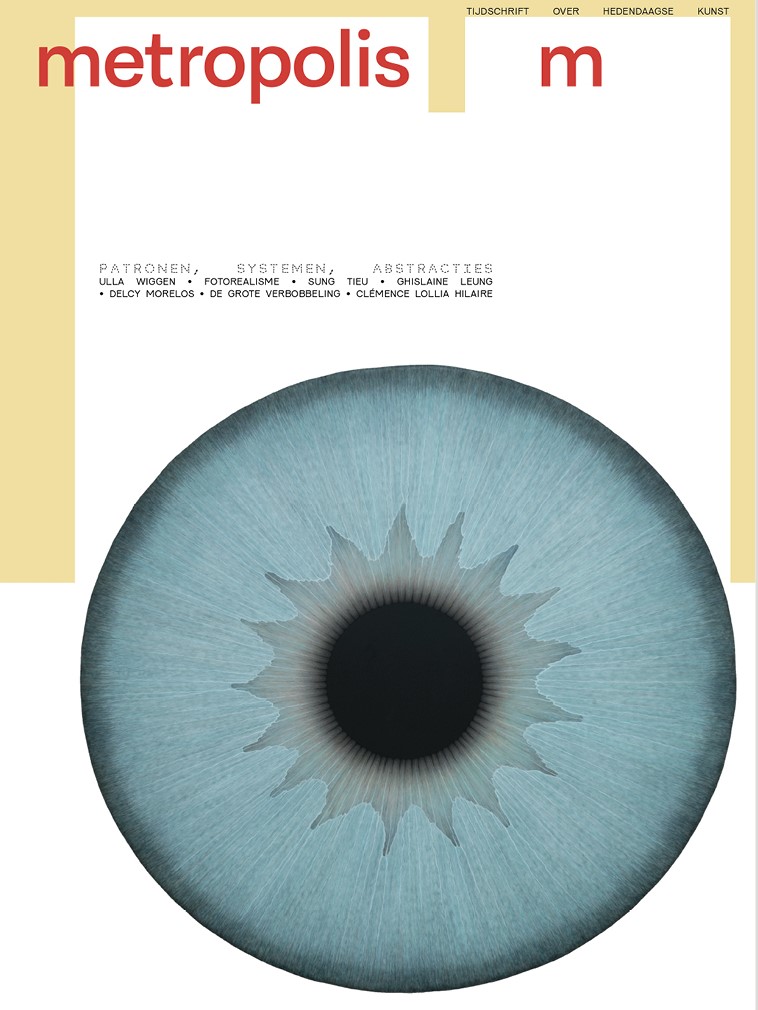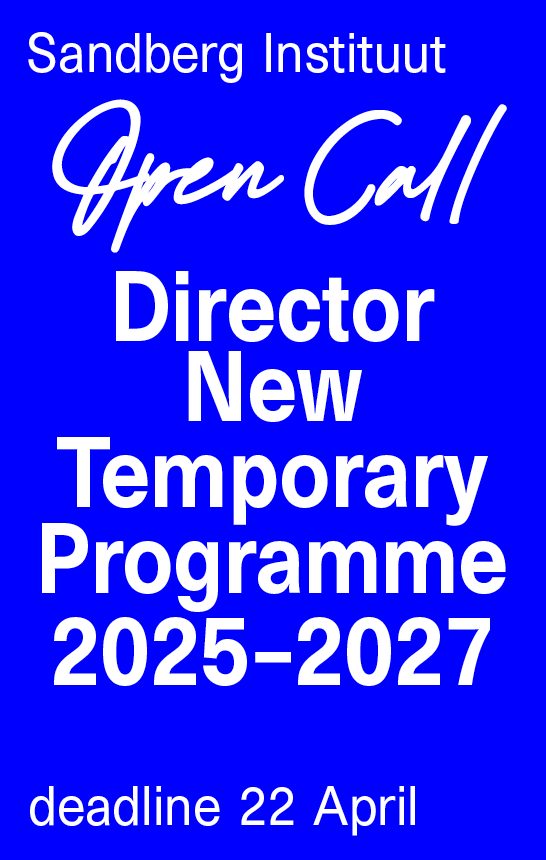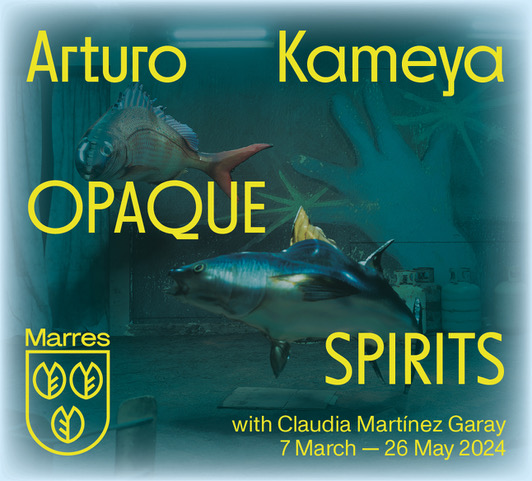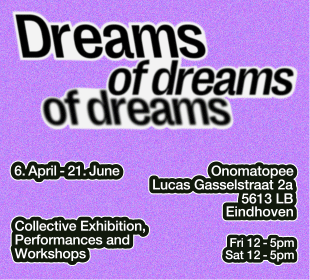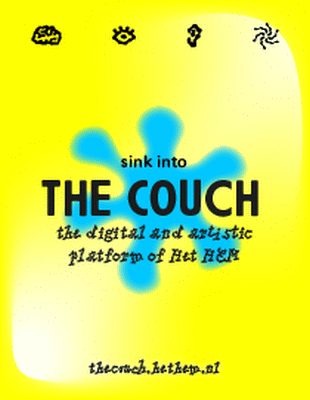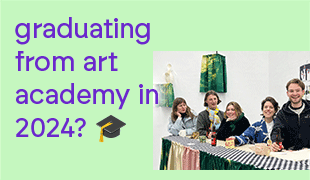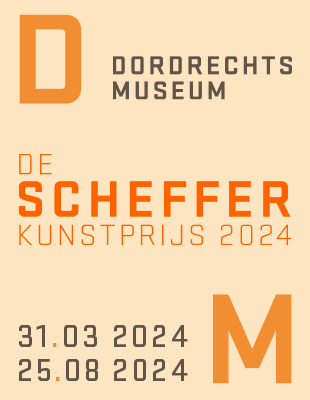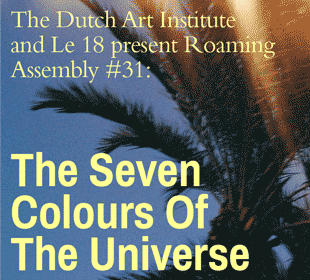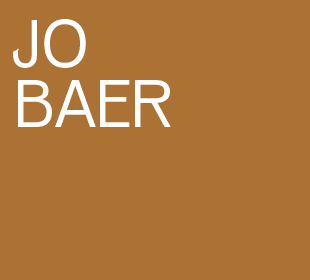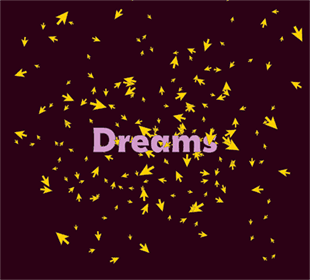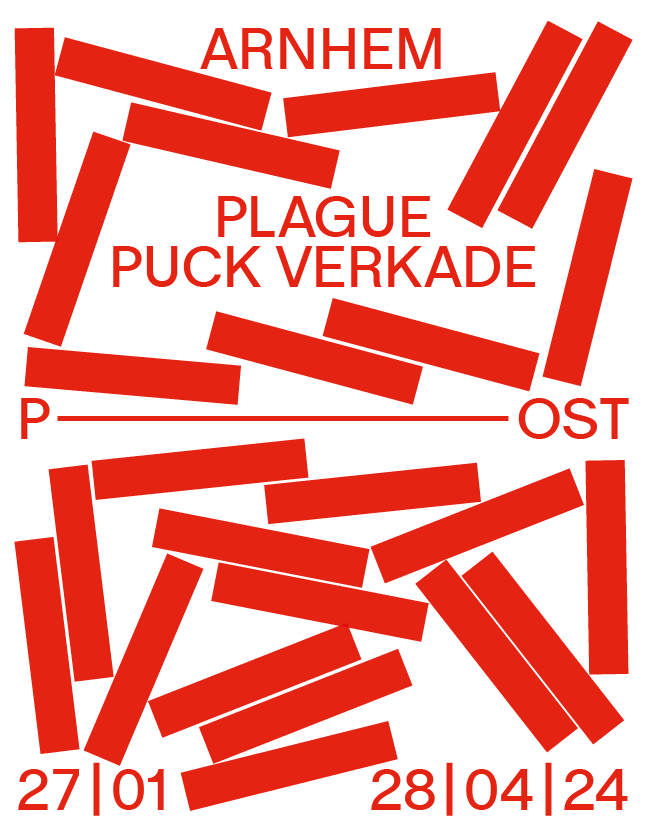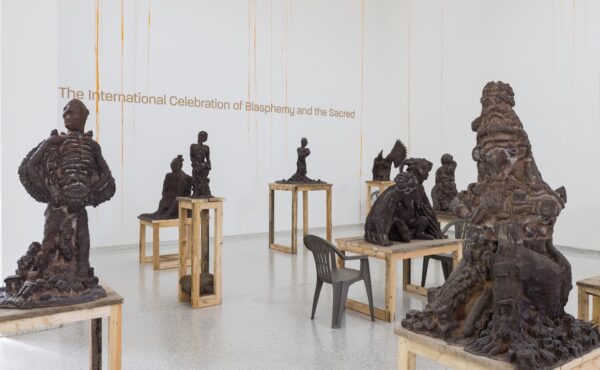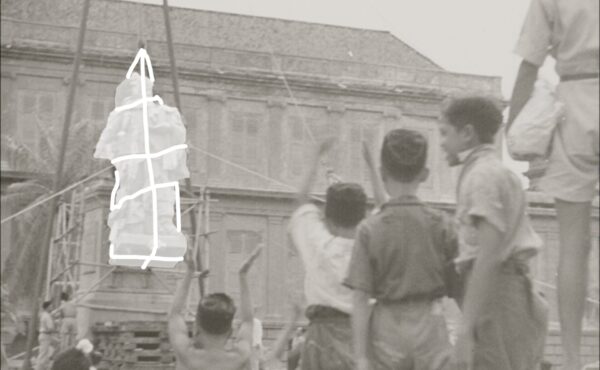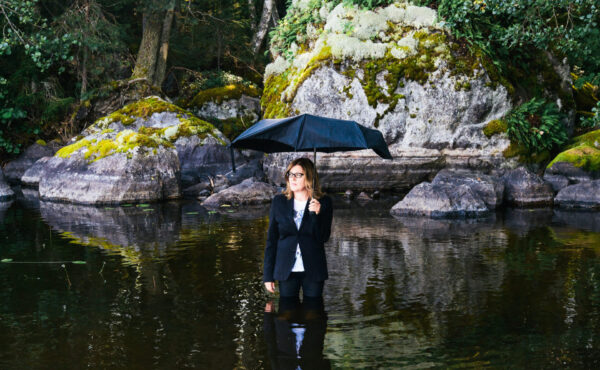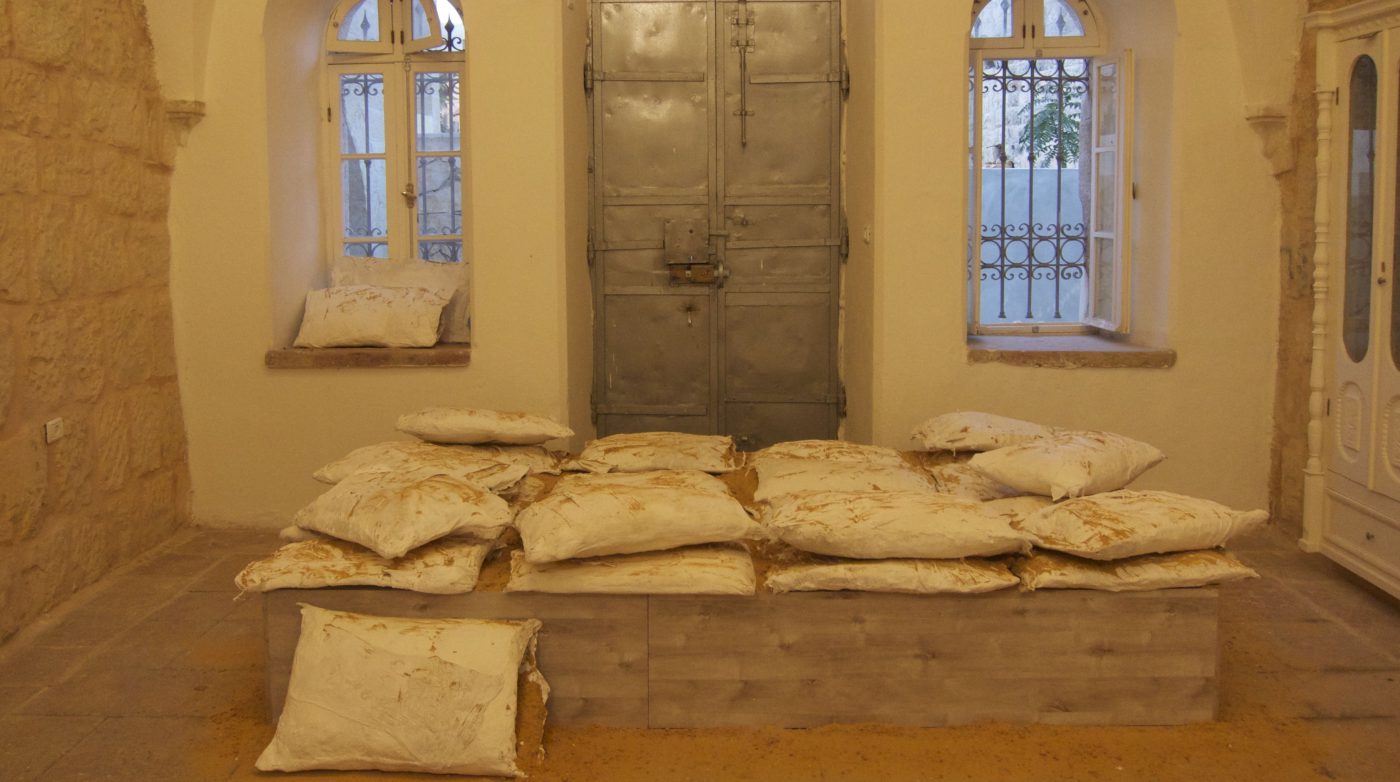
The Sea is Mine, Qalandiya International, Palestine
The very name of this recently (2012) established biennial is a good indication of what is at stake in the third edition that I was able to visit partly.
Qalandiya is a village between the cities of Jerusalem and Ramallah, now divided by a separation wall, and also the site of a 1948 refugee camp. Nowadays it is mostly known as a busy checkpoint between the mutually contested territories of Israel and Palestine. ‘Checkpoint’ is a euphemism for something that gives an impression of what a small transit concentration camp might look like, if such a thing was not an anachronism in the 21st century. Yet it exists, and its atmospheric qualities cast the origins of the Qalandiya Biennial in the existential shadows of despair, anger, resistance, and an incessant search for identity.
Spreading out to venues in Jerusalem, the Ramallah conglomerate, Birzeit, Bethlehem and Haifa, and also Amman, Beirut and London, the biennial is a statement on the inclusion of such diverse locations as territories of Palestinian culture, the very manifestation of which is a proof of the viability of a unified culture formation, dispersed or not.
Manifestations of culture are increasingly becoming a tool of soft power for the Palestinian cause. The recently opened Palestinian Museum in Birzeit near Ramallah with its impressive architecture is just one proof of that, although it does not have anything on display yet. Its recently ousted director Jack Persekian, director of Al-Ma’mal Foundation and gallery in Jerusalem, envisioned it as a project of inclusiveness for the Palestinian community at large, both inside and outside of Israel and the Middle East. This is the general policy of the Palestinian Museum, but with the appointment of his successor Mahmoud Hawari, an archaeologist affiliated with the British Museum, it now seems also to aspire a role in the appropriation of the archaeological heritage of the Holy Land, which hitherto has been the exclusive – and fiercely contested – playfield of the colonizer.
What seems as the most important point of discussion here is whether Palestine is to be considered a rigidly fixed cultural entity and territory, or a flexible and inclusive social and cultural construction, and how far such divergent opinions can materialize in cultural institutions at all. Like institutions realized on the other side of the checkpoint. The Israel Museum for instance is the cultural vehicle of the territorial claim of the Israeli state. Its collection ranges from archaeological artefacts from 10.000 BC up to contemporary art and design, presented on a scale far beyond the Palestinian Museum. One of the museum’s branches, the Rockefeller Archaeological Museum, displays, among many other things, a meters long vitrine that contains pottery fragments of successive archaeological periods dug up in Palestine. Instead of lengthy explanations, and as a frivolous gesture in a setting that is subjugated to rigid chronological interpretation, the successive colours of the pottery samples from different periods form an easy comprehensible chart that speaks for itself.
It is referenced by a work by Aya Kirresh, A concrete ode to history. It consists of a sculpture that resembles a drill core; a cylindrical sample of earth that reveals successive stages of geographical formation usually expressed by colour differentiations. But this is a reconstructed drill core made of concrete. In the same vein as the Rockefeller pottery fragments, Kirresh charts the history of concrete used on Palestinian territory. She also starts around 10.000 BC. From the red and yellow mud of the earliest houses, she traces the use of concrete up to the present and distinguishes different colour aspects over successive periods of time. In the middle, a deep cleft turns up: we are in 1948 – the year of Al-Nakba (or ‘catastrophe’, as the year of the proclamation of the independent state of Israel and subsequent cleansing of the land is called by Palestinians). From there, the concrete abruptly turns grey, resembling the hasty and cheap architecture of emergency edifices, refugee camps, separation walls and control towers. But it ends happily with the shiny white concrete commonly used in the West Bank’s current building frenzy: many Palestinians have a share in neoliberalism’s surplus capital reinvested in real estate. And art objects.
We are in the exhibition Pattern Recognition with nine shortlisted artists of the Young Artist of the Year / Hassan Hourani Award 2016, curated by Nat Muller and part of Qalandiya International 2016. It takes place in a renovated house in Ramallah’s historical city centre, a beautiful venue. The Award is a confirmation of growing confidence in contemporary Palestinian art, but making the exhibition was not always easy. For instance, the installation Dream is Possible by Majdal Nateel, made of plaster and cloth among other things, had to be duplicated in its entirety, due to the severe transport and travel restrictions from and to Gaza. Other participants have more luck with their passport identity designations and are rising in the international art world, like media artist Noor Abed. She is showing an intriguing installation that departs from the sight of an unidentified flying creature over Bir-Nabala, a Palestinian village walled-in by the separation barrier. The installation speculates on material evidence of this appearance and hence, on new forms of economic attractiveness of the town, that was a commercial centre thriving on trade with nearby Jerusalem before the wall.
A little further, at Birzeit University Museum, the theme of erasure and destruction that hovers over the Qalandiya International is also met with a touch of humour and a dose of healthy cynicism. The exhibition Gaza – Reconstruction questions ‘whether the inevitable economic doctrine of reconstruction complements the perpetual Israeli military destruction of Gaza, by removing what is left of its social sphere and resilient communities and replacing them with a neo-corporate Gaza.’ Artists as well as a group of students of the International Academy of Art Palestine and the Architecture Department of Birzeit University took up a remote perspective on the inaccessible strip, focusing instead on the perpetual forms of destruction and reconstruction throughout the scattered Palestinian territory, and on the biased image production that radiates from Gaza. The city is a fetish for numerous NGO’s willing to invest their financial aid if based on neoliberal premises, in which libidinal global capitalism merges with couleur locale. The resulting works, installations and projects tap into these contradictory sentiments surrounding Gaza’s reconstruction, with often hilarious outcomes. The level of criticism in this well-designed comprehensive exhibition bears the mark of the University’s cheerful spirit of independent thinking.
The image of a Palestine enmeshed in the colonizing practices of Israel at one side, and on the other by capitalism’s ruthless cultural logic, is less strong in the Haifa venue of the Qalandiya International. Relatively remote from the daily affairs in the two big cities of Jerusalem and Ramallah, Haifa is considered a fine example of cohabitation between the various peoples that inhabit the Holy Land, including Palestinians. Yet, according to the Arab Culture Association, the organizer of the photography exhibition Returning to the Sea, the situation is less rosy. Returning to the Sea aims at former inhabitants of coastal villages erased in Al-Nakba, at Palestinians of the nearby West Bank who in general are not able to go to the seaside at all (hence the title of the biennial: The Sea is Mine – a claim to the sea), and at the difficulties and discrimination that Arab inhabitants experience in the few remaining cohabited towns on the coast where they continue to live, such as Haifa and Jaffa. The Arab Culture Association complains about the governmental opposition against its efforts to obtain, as its centre for activities, the dilapidated building of a former cinema that currently functions as a discotheque. It nevertheless made the exhibition in what still is the discotheque, using the dark and gloomy interior as the stage for probing photographs. The curator, photographer Mohamed Badarne, compiled an exhibition with more or less renowned photographers and self-taught artists, mostly of Palestinian descent, and mixed their work with projects by the members of workshops, one of which he supervised himself, the Athar Group. The Athar Group took as its focal point the situation in poverty-stricken Jisr Al-Zarqa, the only remaining Palestinian coastal village in the north of Israel, locked-in by infrastructural works, yet still open to the sea. The photographs themselves are often gentle and nice, offering strong images that go against the usual stereotypes of resistance, suppression and religion. Yet, when the visit through the dark spaces unfolds one gets slowly a grasp of Badarne’s activism. The idea that this is shared with the discotheque public probably makes it the strongest socially committed contribution to the Qalandiya International 2016.
Meanwhile, in Bethlehem, just after passing yet another small transit concentration camp you will find the headquarters of the Bank of Palestine, where an overview of Palestinian modern art has been installed. Unfortunately, it is not part of the Qalandiya circus. The exhibition is drawn exclusively from a private collection. Here we find the construction of Palestinian art history as we speak. Dedicated uniquely to work of artists from approved Palestinian descent, the focus is on traditional media – mostly painting – as to underscore the fact that this is classic art history. Its chronology is not based on stylistic progress but instead rooted in the aforementioned incentives of despair, anger, resistance and a search for an identity to replace the one erased by Al-Nakba. The origins of this identity are here to be found in samples of icon painting from the end of the 19th century, from where the exhibition continues with stylistic polyphony into the beginning of the 21st century. Although it looks tame, its fiery political context marks it with a radiating aura, making each piece more human than what is to be found in any other regular modern art museum with its worship of objectified coolness.
And it pays off. At the other side of the checkpoint, in the Israel Museum, some of the artists among the already marginalized presence of Arabs in the contemporary collection are now designated as ‘Palestinian’ on the captions. Although absolutely marginal, this bears perhaps the sign of a nascent approval of the existence of a non-Israeli version of Palestine. That is no less than a revolution.
Yet, such binary exclusivism and cultural essentialism, although at moments necessary and inevitable, go against the vision of inclusiveness promoted by Jack Persekian, among others. What this vision entails can be grasped through the Jerusalem Show, organized by his Al-Ma’mal Foundation as part of the Qalandiya International. Vivian Ziherl curated this year’s edition. Quite a challenge, as it was meant to take place both in Al-Ma’mal gallery in the Old City and in a cultural centre in Shuafat refugee camp in East Jerusalem. One week before the opening, local authorities withdrew the option of this second venue and the project had to be relocated to some empty spaces nearby Al-Ma’mal. It turned out quite positive though.
The focus is on articulations from and giving voice to minority cultures that are usually discriminated, repressed or redressed by institutionalized cultural hegemonies
Ziherl’s show is titled Before and after origins, in which the ’category of “origins” is questioned throughout the show, contouring the relations of modernity, colonization, property and territorial belonging’. Such a program is not restricted to Palestinians only. Like in Ziherl’s recent project Bell Invites at Stedelijk Museum Bureau Amsterdam, which she organized together with Richard Bell and Aruna Vermeulen, the focus is on articulations from and giving voice to minority cultures that are usually discriminated, repressed or redressed by institutionalized cultural hegemonies.
In Ziherl’s show, this means the expressions are not only of fine artists per se and not restricted to Palestinians only (those included are mostly from refugee camps and occupied Golan, thus representing Palestinian minorities). Before and after origins also includes a range of (urban) Aboriginal artists, black South-Africans, an Afro-European and even a representative of the Shan minority in Myanmar, alongside a few other West-European artists known for their criticism towards the colonization of the self by capitalism and cultural essentialism. These latter two factors lead to a persistent and depressing focus on commodities and real estate in museums that are ignorant of the political agency of art. The Jerusalem Show hints at a way out of this institutional deadlock. The contributions are extremely concentrated and smart, and reveal the touch of humanity and the self beyond the object.
With rigid cultural essentialism Palestine might follow in the footsteps of the colonizer. With rigid inclusivity and social commitment Palestine risks not gaining any soft power at all through art. The Qalandiya International 2016 oscillates between these poles and one senses the zealous discussions behind this operation. And I did not even discuss many of the other venues and events, such as Jumana Emil Abboud’s solo exhibition at Khalil Sakakini Cultural Center (Ramallah), curated by Lara Khaldi; Sites of Return initiated by Ramallah Municipality in some of its historic venues or the super interesting Series of Un-Curated Events in Birzeit’s historic center organized by Riwaq; and the (partly outdoor) activities of Al Hoash Palestinian Art Court in East Jerusalem. Nor did I speak of the off-program with for instance the exhibition Disarming Design from Palestine in Ramallah, organized by a team that includes the Dutch designer Annelys de Vet; Ramallah’s blue-chip Gallery One’s solo exhibition of Sharif Waked, whose work is even collected ‘on the other side’; and Ramallah-based Gallery Zawyeh’s open studio program that includes among others senior Palestinian artist Jawad Al Malhi from Shuafat. If a good reason is needed to cross some checkpoints, Qalandiya International provided more than one.
This Sea is Mine, Qalandiya Biennial, 5-31 October 2016
Jelle Bouwhuis
PhD onderzoeker Moderne Kunstmusea, Globalisering en Diversiteit, VU Amsterdam